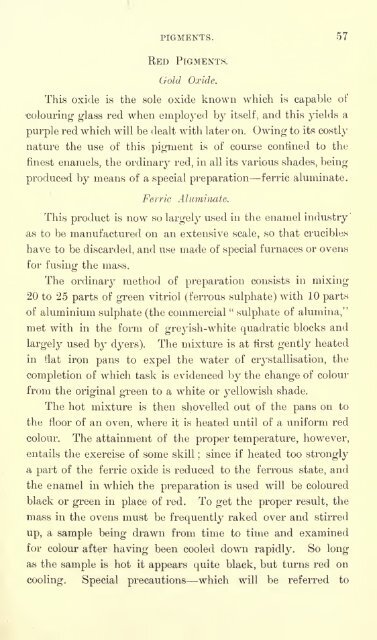Enamels and enamelling; an introduction to the preparation and ...
Enamels and enamelling; an introduction to the preparation and ...
Enamels and enamelling; an introduction to the preparation and ...
You also want an ePaper? Increase the reach of your titles
YUMPU automatically turns print PDFs into web optimized ePapers that Google loves.
PIGMENTS. 57<br />
RED PIGMENTS.<br />
Gold Oxide.<br />
This oxide is <strong>the</strong> sole oxide known which is capable of<br />
colouring glass red when employed by itself, <strong><strong>an</strong>d</strong> this yields a<br />
purple red which will be dealt with later on. Owing <strong>to</strong> its costly<br />
nature <strong>the</strong> use of this pigment is of course confined <strong>to</strong> <strong>the</strong><br />
finest enamels, <strong>the</strong> ordinary red, in all its various shades, being<br />
produced by me<strong>an</strong>s of a special <strong>preparation</strong> ferric aluminate.<br />
Ferric Aluminate.<br />
This product is now so largely used in <strong>the</strong> enamel industry<br />
as <strong>to</strong> be m<strong>an</strong>ufactured on <strong>an</strong> extensive scale, so that crucibles<br />
have <strong>to</strong> be discarded, <strong><strong>an</strong>d</strong> use made of special furnaces or ovens<br />
for fusing <strong>the</strong> mass.<br />
The ordinary method of <strong>preparation</strong> consists in mixing<br />
20 <strong>to</strong> 25 parts of green vitriol (ferrous sulphate) with 10 parts<br />
of aluminium sulphate (<strong>the</strong> commercial "<br />
sulphate of alumina,"<br />
met with in <strong>the</strong> form of greyish-white quadratic blocks <strong><strong>an</strong>d</strong><br />
largely used by dyers).<br />
The mixture is at first gently heated<br />
in tiat iron p<strong>an</strong>s <strong>to</strong> expel <strong>the</strong> water of crystallisation, <strong>the</strong><br />
completion of which task is evidenced by <strong>the</strong> ch<strong>an</strong>ge of colour<br />
from <strong>the</strong> original green <strong>to</strong> a white or yellowish shade.<br />
The hot mixture is <strong>the</strong>n shovelled out of <strong>the</strong> p<strong>an</strong>s on <strong>to</strong><br />
<strong>the</strong> floor of <strong>an</strong> oven, where it is heated until of a uniform red<br />
colour. The attainment of <strong>the</strong> proper temperature, however,<br />
entails <strong>the</strong> exercise of some skill ; since if heated <strong>to</strong>o strongly<br />
a part of <strong>the</strong> ferric oxide is reduced <strong>to</strong> <strong>the</strong> ferrous state, <strong><strong>an</strong>d</strong><br />
<strong>the</strong> enamel in which <strong>the</strong> <strong>preparation</strong> is used will be coloured<br />
black or green in place of red. To get <strong>the</strong> proper result, <strong>the</strong><br />
mass in <strong>the</strong> ovens must be frequently raked over <strong><strong>an</strong>d</strong> stirred<br />
up, a sample being<br />
drawn from time <strong>to</strong> time <strong><strong>an</strong>d</strong> examined<br />
for colour after having been cooled down rapidly. So long<br />
as <strong>the</strong> sample is hot it appears quite black, but turns red on<br />
cooling. Special precautions which will be referred <strong>to</strong>
















